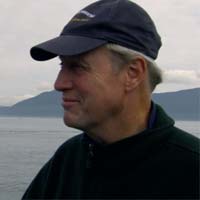I'm a sailor, a crabber, a swimmer, a hiker and sometimes a poor fisherman. I've spent a lot of time over the past 30 years on the Chesapeake Bay. I love the water -- its beauty, its calm, its majesty --and those magical moments when you feel at peace and in harmony with nature. And so a few years ago when the crab catch at the end of my pier on the Magothy River was looking pretty skimpy and some friends told me that the Bay was in trouble, I thought that maybe it was worth my looking into as a reporter.
 I'm a sailor, a crabber, a swimmer, a hiker, and sometimes a poor fisherman. I've spent a lot of time over the past 30 years on the Chesapeake Bay. I love the water -- its beauty, its calm, its majesty -- and those magical moments when you feel at peace and in harmony with nature. And so a few years ago when the crab catch at the end of my pier on the Magothy River was looking pretty skimpy and some friends told me that the bay was in trouble, I thought that maybe it was worth my looking into as a reporter.
I'm a sailor, a crabber, a swimmer, a hiker, and sometimes a poor fisherman. I've spent a lot of time over the past 30 years on the Chesapeake Bay. I love the water -- its beauty, its calm, its majesty -- and those magical moments when you feel at peace and in harmony with nature. And so a few years ago when the crab catch at the end of my pier on the Magothy River was looking pretty skimpy and some friends told me that the bay was in trouble, I thought that maybe it was worth my looking into as a reporter.
I had no idea what I was getting into or what I would discover. But after 18 months of reporting and filmmaking on Chesapeake Bay and Puget Sound, another of my favorite places to while away the time, I have come away dismayed. As a guy with eight grandchildren, I am now worried that they and their children are not going to be able to survive on this planet unless we older folks change the way we are destroying and raping Mother Nature.
Under the Clean Water Act, places like Chesapeake Bay, Puget Sound, the Great Lakes and the Everglades were supposed to be fishable and swimmable by 1983. Well, here we are 25 years past that deadline, and we are not remotely close to success.
In Poisoned Waters, we tell the stories of Chesapeake Bay and Puget Sound as case studies. But what we say could be told about the Great Lakes, Everglades, Gulf of Mexico and the rest.
Consider this: Dead zones now occupy 40 percent of the main stem of the Chesapeake in summertime -- and dead zones are underwater regions where not a single crab, or an oyster, or a fish or even a blade of precious bottom grass can live because dead zones are bereft of oxygen. Dead zones aren't just a Chesapeake Bay problem. They are a global problem. Every 10 years, they double in size and number around the world. In the Gulf of Mexico, there's a dead zone that is as large as the state of Massachusetts.
And what causes dead zones? Excess nitrogen and phosphorous runoff in the water that causes masses of algae to bloom. When it dies, algae sinks to the bottom and sucks all the oxygen out of the water. Here on the Chesapeake, the main sources of all that excess nitrogen and phosphorous are the cattle farms along the Susquehanna River in southern Pennsylvania and the chicken farms on the bay's Eastern Shore that produce 1.5 billion pounds of manure every year. That's more manure than the human waste from four major cities -- New York, Washington, San Francisco and Atlanta -- put together. The human waste gets treated; the animal waste doesn't. Not just a problem on the Chesapeake but from hog farms in the Carolinas and Iowa, cattle farms in Wisconsin, poultry farms in Arkansas and Texas.
Pollution today is greatly changed from the 1970s when we celebrated our first big Earth Day and the EPA was moving mountains. Then we saw the problem as a bunch of big polluters. We could see, smell and touch the ugly green beds of algae floating on the Potomac River.
Today, some of the worst pollution is invisible. The water looks OK, but science tells us it is not.
Take for example, our drinking water. The U.S. Geological Survey has been testing rivers and drinking water systems all over the country, including the Potomac River right at the intake for the Washington Aqueduct that supplies tap and drinking water to a million or more people in the D.C. area. USGS teams found some 85 worrisome chemical compounds on their watch list in the water entering into the Washington Aqueduct and two-thirds of them got through the filters and into the tap water for homes, businesses and government offices in the D.C. area.
Scientists at the National Institute for Environmental Health Studies and Johns Hopkins University's School of Public Health tell us these chemicals and others include endocrine disruptors that kill fish, cause mutations among frogs, and threaten human health, raising the risks of breast cancer among women, lower sperm count among men, and male genital anomalies among infants. Pretty worrisome stuff. And this is not just a problem on the Potomac River. The USGS study found the same thing in tests all around the country.
So you can see why I'm worried about my grandchildren.